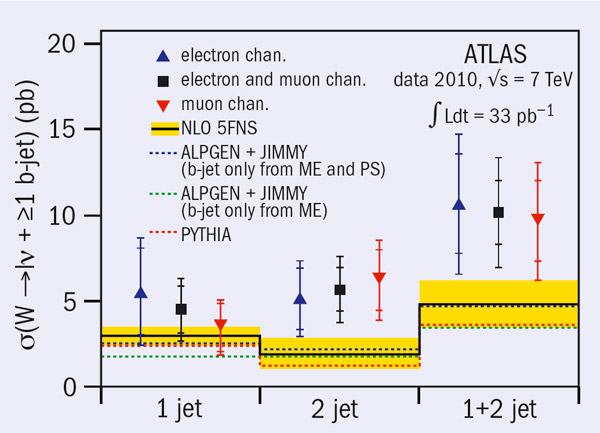
While searches with 2011 LHC data for the Higgs and new physics caught the headlines over the summer, detailed studies of 2010 data continue to yield high-precision physics. For example, the ATLAS collaboration has published a number of results on the production of vector bosons (W and Z) based on the full 2010 dataset of 37 pb–1, including measurements that require additional jets in the final state.
The challenge of precision measurements of Standard Model vector-boson production is to understand and control the systematic uncertainties; this contrasts with many analyses that are still dominated by statistical uncertainties and can thus “simply” wait for more data. This challenge will increase in analyses of the larger 2011 data set, where ATLAS will probe higher jet-multiplicities and higher jet transverse-momenta. In addition to precise measurements of electroweak parameters, the study of W and Z bosons at the LHC tests perturbative QCD (pQCD) and it constrains the distribution of partons (quarks and gluons) inside the proton. W and Z bosons are also studied as background to other Standard Model signals and to look for new physics.
Two recent ATLAS results have focused on the production of a vector boson together with jets from b-quarks. The Z measurement is still statistically limited, while the W measurement is dominated by systematic uncertainties. The cross-section for inclusive Z + b-jets production agrees with next-to-leading-order pQCD calculations. For the production cross-section of a W with one or two b-jets, the results are again consistent within uncertainties, although the value observed is slightly higher than predicted (Fig. 1). These measurements with b-jets not only test pQCD for heavy quarks, they also assess what is a significant background source in searches, for example for associated Higgs production, where H→bb.

Considering the ratio of cross-sections rather than their absolute value has the advantage that many sources of systematic uncertainty cancel. ATLAS has recently published a measurement of the ratio of W and Z cross-sections with exactly one associated jet, complementing measurements of the individual channels. The ratio is measured as a function of the jet transverse-momentum. The systematic and statistical uncertainties are of comparable size, thereby providing the basis for a precision test of the Standard Model (Fig. 2). The results are in reasonably good agreement with a number of Monte Carlo predictions.
Further reading
ATLAS collaboration arXiv:1109.1403, arXiv:1109.1470, arXiv:1108.4908.
ATLAS collaboration ATLAS-CONF-2011-042, ATLAS-CONF-2011-060.








